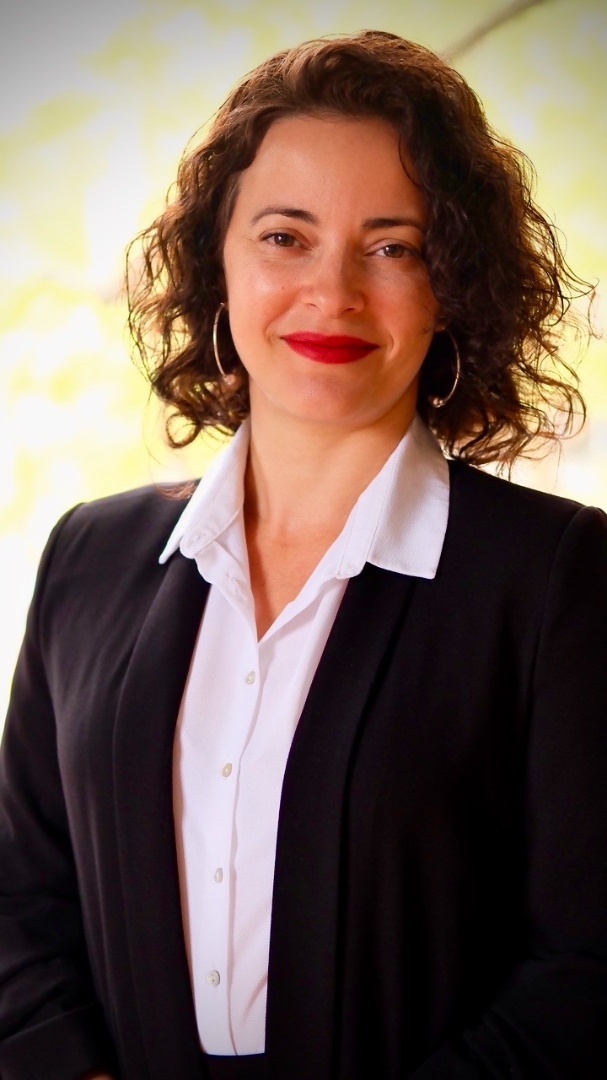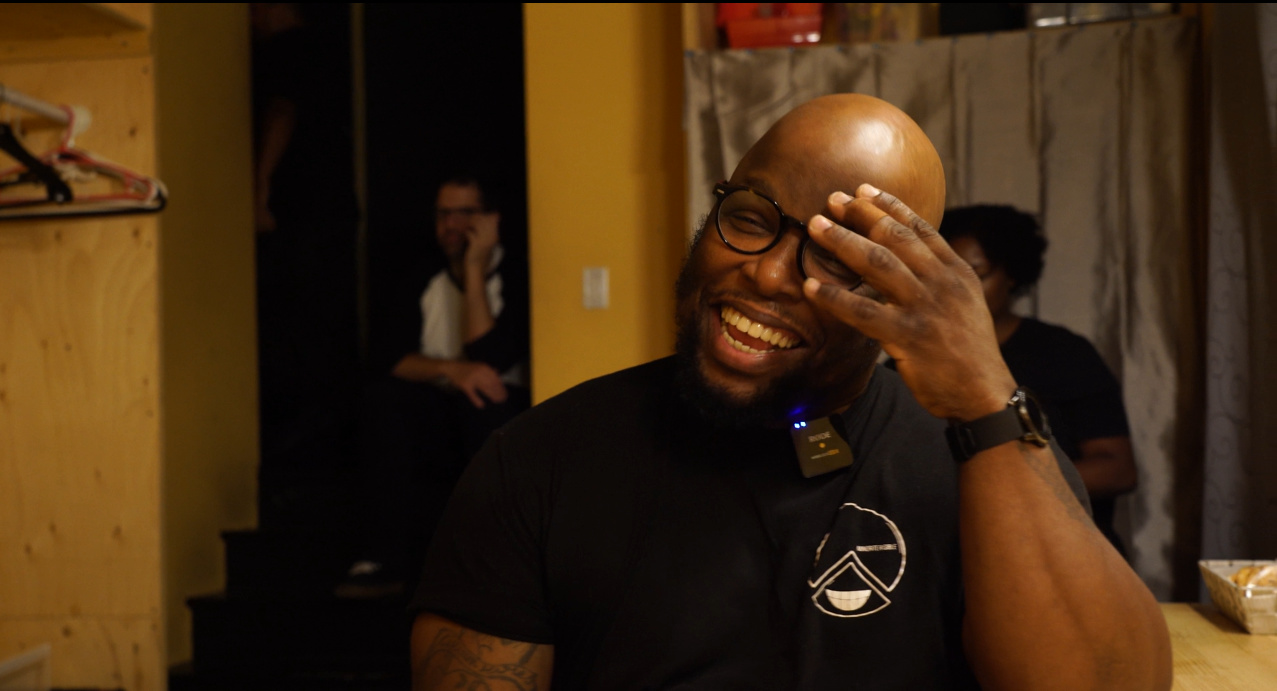In both Quebec and the United States, the roles written for Hispanic women often fail to reflect reality, whether it’s big-budget or indie TV and film productions. While we’ve seen progress in the kinds of characters being written, stereotypes still stubbornly persist on screen. We spoke to Fatima Lopez, an up-and-coming actress; Carolina*, a screenwriter; and Dr Zaira Zarza, a researcher and associate professor at the Université de Montréal, to hear their thoughts from inside the industry.
A blue and green wool jacket is draped over a chair at the Café des Arts. It’s early July, well into summer, but the jacket’s owner, Fatima Lopez, isn’t far. We’ve arranged to meet her here. On one of the four walls around the café, acrylic paintings signed by Enriqueta Ahrensburg hang noticeably. Lopez returns, grabs her jacket, and we make the move to a larger table just behind us.
She’s 25, an actress by trade, and was born in Buenos Aires, Argentina. After several moves back and forth between Argentina’s capital and Montreal, her family settled here for good in 2016. Growing up in the city’s West Island, she enrolled at John Abbott College’s English-language theatre program, before finishing her training at the National Theatre School of Canada.
We ask about her experience as an actress since 2021. She pulls out her phone and reveals a goldmine: an Excel spreadsheet listing every role she’s auditioned for over the past year, along with matching character descriptions. A colour code distinguishes roles for TV versus film. According to her observations, French-language series tend to lean more into seductive portrayals of Hispanic women. “I realized that in [Canadian] English-language series, there were fewer descriptions like ‘fiery’ or ‘seductive.’ But in [English Canadian] films, those adjectives popped up more often—strong, tough, headstrong, fiery,” she says, clenching her fist to make her point.
Lopez feels Hispanic women on screen are often subject to a kind of fetishization: the accent, the curves, and so on. That “sexy Latina” stereotype, she explains, just doesn’t match real life. “It bothers me when someone says ‘Latinas’ and what they really mean is just [a girl with an accent and curves],” Lopez says, her face animated as she recounts her experiences. “Latinas come in all shapes, genders, and types!”
She points at her phone on the table and to the file she’s kept updated since 2024. “Out of all the auditions I’ve done for Latina characters, only one was written by a Latina,” she says, visibly frustrated by the situation. “That’s where the stereotypes come from—when someone outside our culture is writing the characters, they’re going to bring their own perspective. I’m not saying that white, Black, or Asian writers shouldn’t create roles for us [...], but we need diversity on set, not just in front of the camera!”
Her constant travels between Latin America and North America exposed her to vastly different cinematic worlds. Back then, she didn’t find Argentinian films “cool” like American ones, and didn’t consume much from her country of origin. “It kept me from being influenced by Argentina. We have amazing actors and a lot of talent, but I didn’t watch them because I wanted to be a white, American actress,” she explains. “Watching TV, it was mostly white women who had the lead roles.”
It was Wizards of Waverly Place, with its Italo-Mexican main characters, that helped her realize she could be an actress without rejecting where she came from.
To recognize oneself on screen
A few days later, we meet Carolina, a screenwriter. On Henri-Julien Avenue in Montreal, one of the entrances to the Jean-Talon Market greets visitors on this scorching July day. Three birds lands on the pavement and hop toward a pie vendor’s counter before flying off down another corridor. Carolina joins us at one of the high tables near the entrance, under the covered roof. Her braided hair frames her face. Under one arm, a large carton of eggs hides her multicolored handbag—black, orange, pink, and green. We’d already asked her a few questions over the phone, and her perspective as an experienced Latina screenwriter helps us better understand the power production teams hold during the pre-production process.
Her verdict is clear: she shares that in Quebec, roles written for Hispanic women often depict them as humiliated or suffering. Back in the 90s, Latin American women were often cast as cleaning ladies, mothers crying for their sons at the courthouse, or victims of violence, Carolina explains.
Still, she’s aware of the limitations some writing teams face. “It’s really hard to write for cultures you don’t encounter regularly,” she says, eyes drifting to the ceiling. “If the only Latina in your entourage is a cleaning lady, that’s who you’re going to write.”
.jpeg)
Character briefs aren’t usually created out of bad intent, she clarifies, but rather from a lack of imagination. “There’s always this snobby Westmount woman who criticizes the main character for being rude at a restaurant. Why can’t she be Latina? She never is. The snob is always white; that role is tied to a social class,” Carolina observes.
Her braid falls over her shoulder as she runs her fingers through it. “I’d love to see us in different social roles. Why can’t we be the inspiring French teacher who changes a student’s life? Seeing Latinas in more varied roles would be so empowering,” she says. “Those positive models are really important for younger generations.”
She compares it to the theatre industry in the province, one she also works in. She describes it as originally dominated by the French. “It wasn’t until Quebecers saw themselves on stage that they began to recognize themselves as a people.” Her hands gesture in front of her white tank top as she continues. “That’s why it’s so important to see people from different backgrounds on TV. That’s how you integrate them into society. When they see themselves, they’ll know they belong.”
Carolina brings up Brooklyn 99, the American series adapted in Quebec in 2020, and the controversy that followed. In the original, two detectives are played by Stephanie Beatriz (born in Argentina) and Melissa Fumero (daughter of Cuban immigrants). “That’s a perfect example: they’re Latina women, cops, top of their class, super smart, a little awkward… they’re fantastic, complex characters who aren’t defined by being Latina,” Carolina says.
But in the Quebec adaptation, the roles went to Mylène Mackay and Bianca Gervais—neither of whom are Latina. “The writers said there were more Latinos in the U.S. than in Quebec, and they wanted to reflect Quebec reality. I get it, it’s not the same context,” she concedes. In 2020, Hispanic people made up nearly 27% of NYC’s population, compared to 1.6% of Quebec City’s in 2021.
Despite backlash in both Quebec and the U.S. over the casting change, Carolina acknowledges that the province has improved in terms of diversity in cinema and TV. “Right now, we’re figuring out how to make it feel real and organic. But in Quebec, we’re still in that awkward teenage phase. It’s not a finished product yet. There’s still a lot of clumsiness, but the will is there. We’ve made progress, and we shouldn’t forget that.”
Time is ticking; she has another appointment soon but agrees to answer a few more questions. She shares that in her free time, she takes note of up-and-coming Latino artists, as well as the kind of presence and performances they bring. “There’s a wave of [artists] coming out of the schools right now. So much more diversity—they’re going to bring freshness and authenticity.” Her expression turns thoughtful. Still, she notes, economic instability in the arts remains a barrier for immigrant children. “When your parents sacrificed everything to move to a new country, it’s hard to tell them, ‘I’m going to gamble on a career that might not pay.’”
To better reflect the realities of communities on screen, research is essential, she says. “It’s our job to do what’s called character work—to deepen it, make it real. I try to learn as much as possible. If I’m writing about a culture I don’t know well, I’ll watch documentaries, read books from that culture, try to learn as much as I can to keep it… real.”
“Any country's cinema starts with education”
Almost a week later, Dr Zaira Zarza, associate professor in the department of art history and film and media studies at Université de Montréal, joins us via Zoom. Her short black hair frames her face, matching her deep brown eyes.

The interview barely begins and Zaira enthusiastically rattles off cinematic references. Le Coyote and Les routes en février were both directed by Katherine Jerkovic, who has roots in Uruguay, Argentina, and Croatia. The latter was the first Quebec film shot in Uruguay and in Spanish. Mis dos voces, by Lina Rodriguez, was entirely filmed in Canada. These three nationally acclaimed films are deeply rooted in the Latin Canadian experience and spotlight actresses from Latin America. “It’s the intimacy, the vulnerability in [their] characters that makes their films, to me, the most authentic, the most honest representation of immigrant realities—especially for women,” she says, eyes focused on her screen.
Zaira briefly turns to the U.S. situation, counting on one hand the Hispanic American actresses frequently seen on screen. “Do we see a lot of Latina women or filmmakers? No. Are they everywhere in the media? Are they mainstream? Do they have space in Hollywood? No.” According to a 2019 study from USC Annenberg School analyzing 1,200 films from 2007 to 2018, only 19 producers were Hispanic women. Four per cent of directors were Latino. Of those, only one was a Latina woman.
Immigrants face many barriers entering this profession in a new country, Zaira adds. “It’s already hard for people born in Canada or Quebec to enter the industry. Imagine how hard it is when French or English isn’t your first language, when you don’t understand the film funding system here, such as SODEC, Québecor, and the National Film Board. These are art forms that absolutely require funding,” she explains empathetically.
In Quebec and the U.S., filmmakers are heavily dependent on cultural funding policies. Government decisions determine who gets visibility, especially those tackling social or political themes. Zaira points to the aftermath of the George Floyd protests and the #MeToo movement as examples. “There was some funding for racialized producers, for Indigenous filmmakers—groups that previously had very limited access to grants. But these measures are still cosmetic. In a perfect world, those types of grants shouldn’t need to exist.”
We have seven minutes left before the Zoom call ends. Her eyes drift around her home, then settle back on the screen. For this seasoned professor, one thing is certain: it all begins in the classroom. “Cinema in any country, in my opinion, starts with education. [If] I don’t see an Indigenous student in a classroom at Université de Montréal, no Latina women, I can imagine what’s going to be missing on screens later,” she says. It’s essential to attract students from a wide range of visible minorities into the arts, culture, and media sectors. “It’s hard, because [these are] often privileged, elitist fields. [...] We have to break down those walls when it comes to the arts!”
*Name has been changed to protect anonymity.




.jpeg)

.jpeg)

.jpg)
.jpg)
.png)